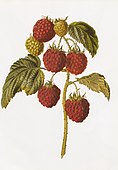Augusta Innes Withers
Augusta Innes Withers | |
|---|---|
 | |
| Born | Augusta Hanna Elizabeth Innes Baker 1792 Gloucestershire, England |
| Died | 1877 |
| Nationality | English |
| Occupation | Illustrator |
| Spouse | Theodore Withers |
Augusta Hanna Elizabeth Innes Withers (née Baker; 1792, Gloucestershire – 1877, London), was an English natural history illustrator, known for her illustrating of John Lindley's Pomological Magazine and her collaboration with Sarah Drake on the monumental Orchidaceae of Mexico and Guatemala by James Bateman. She was appointed "Flower Painter in Ordinary" to Queen Adelaide and later to Queen Victoria. She also produced illustrations for Benjamin Maund's Botanis, the Transactions of the Horticultural Society of London, the Illustrated Bouquet (1857-1863) and Curtis's Botanical Magazine.[1]
Family background
Augusta was the daughter of a Gloucestershire vicar, chaplain to the Prince Regent. She lived in London all her life and was married to Theodore Gibson Withers, an accountant, who was 20 years her senior. They were married on 23 July 1822 in Marylebone.[2]
Career
Besides giving painting classes, she was active as a painter from before 1827 until 1865, exhibiting from 1829 to 1846 at the Royal Academy, the Society of British Artists and the New Watercolour Society[3] as well as the Society of Female Artists in 1857 and 1858, and where she was a founder member.[4]
John Claudius Loudon commented in the 1831 Gardener's Magazine that her talents were of the highest order, and that "to be able to draw flowers botanically, and fruit horticulturally, that is, with the characteristics by which varieties and subvarieties are distinguished, is one of the most useful accomplishments of your ladies of leisure, living in the country."[5]
In 1815, in an attempt to clarify the nomenclature of cultivated fruit varieties and reduce the number of synonyms in common use, William Jackson Hooker initiated a project of fruit drawings in watercolour stretching over 10 volumes. Suffering a stroke in 1820, Hooker was unable to finish the work. Four other artists, including Augusta Innes Withers and Barbara Cotton were commissioned to complete the work,[6] ironic since Withers had been refused a position as a botanical artist by Hooker's son, Joseph Dalton Hooker.[7]
Withers painted the 12 colour plates for Robert Thompson's The gardener's assistant.[8]
Legacy
Her drawings are stored at the Natural History Museum, London, at the Royal Horticultural Society, and at the Fitzwilliam Museum of the University of Cambridge.[9] There are a few of her letters at Windsor Castle.[10]
Illustrations
-
Chysis laevis orchid
-
Acineta barkeri orchid
-
Oncidium incurvum orchid
-
raspberry Barnet
-
Allamanda Schottii
-
Gompholobium splendens
References
- ^ 'Benezit Dictionary of British Graphic Artists and Illustrators', Volume 1 by Oxford University Press
- ^ "Theodore Gibson Withers". England Marriages, 1538–1973, familysearch.org.
- ^ Christopher Wood Gallery Archived November 23, 2009, at the Wayback Machine
- ^ Society of Female Artists. First Exhibition. London, 1857; Society of Female Artists. Second Exhibition. London, 1858.
- ^ Leicester Galleries
- ^ Lindley Library Collections Archived May 26, 2009, at the Wayback Machine
- ^ Florilegius[permanent dead link]
- ^ Thompson, Robert; Withers, Augusta Innes (1859). The gardener's assistant : practical and scientific ; a guide to the formation and management of the kitchen, fruit, and flower garden, and the cultivation of conservatory, green-house, and stove plants, with a copious calendar of gardening operations /. Vol. 1859. London: Blackie & Son.
- ^ Ogilvie, Marilyn Bailey; Harvey, Joy Dorothy, eds. (2000). The Biographical Dictionary of Women in Science: L-Z. Taylor & Francis. p. 1390. ISBN 9780415920407.
- ^ Desmond, Ray, ed. (23 December 2020). "Withers, Mrs. Augusta Innes". Dictionary of British and Irish Botantists and Horticulturalists Including plant collectors, flower painters and garden designers. CRC Press. p. 751. ISBN 9781000162868.
External links
- Illustrations by Augusta Innes Withers

-Bateman_Orch._Mex._Guat._pl._31_(1842).jpg/440px-Chysis_laevis_(spelled_Chysis_loevis)-Bateman_Orch._Mex._Guat._pl._31_(1842).jpg)
-Bateman_Orch._Mex._Guat._pl._8.jpg/440px-Acineta_barkeri_(as_Peristeria_barkeri_)-Bateman_Orch._Mex._Guat._pl._8.jpg)

.jpg/440px-Oncidium_incurvum-Bateman_Orch._Mex._Guat._pl._29_(1841).jpg)


